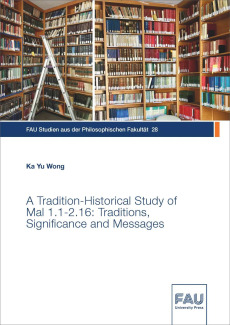Ka Yu Wong
A Tradition-Historical Study of Mal 1.1-2.16: Traditions, Significance and Messages
Reihe: FAU Studien aus der Philosophischen FakultätThis study investigates the significance of the use of traditions in the book of Malachi (“Mal”). Whilst it is a general scholarly consensus that Mal is rich of traditional materials, only a few studies focus on how the traditions used in the book affect our understanding of its messages. Those few studies have the aims (e.g. proving the centrality of the theme of covenant, exploring the scribal activities, etc.) other than searching for the significance of the use of traditions in the formulation of the messages of Mal, and they adopt diversified methods (in theory and/or in practice). By adopting a systematic and text-based method, the present study seeks to fill this lacuna by exploring (1) what traditions were used, (2) how the traditions were used and (3) for what purpose(s) those traditions were used in Mal 1.1-2.16. This study finds that in the said section of Mal, different traditions were utilized in various manners (interpretation, actualization and application) to, on the one hand, address the issues as mentioned in the book and on the other hand, revitalize the authority and relevance of the traditions. As to the scope of this research, it consists of the superscription (Mal 1.1) and the first three “court disputations” (dialectic discourses) of the book (Mal 1.2-5; 1.6-2.9; 2.10-16). Given that numerous traditions are utilized and expressed in different ways therein, the said pericopes are selected as case studies. This dissertation consists of four chapters. Chapter 1 is the introduction with the literature review and statement of problem. Chapter 2 concerns methodological considerations, and the historical and literary aspects of Mal. Chapter 3 is the tradition-historical analysis of Mal 1.1-2.16. Chapter 4 summarizes the findings and concludes the contribution of this study.
Die vorliegende Studie untersucht die Bedeutung der Verwendung von Traditionen im Maleachibuch („Mal“). Während es allgemeiner wissenschaftlicher Konsens ist, dass Mal reich an traditionellen Materialien ist, konzentrieren sich nur wenige Studien darauf, wie diese verwendeten Traditionen in diesem Buch unser Verständnis seiner Botschaften beeinflussen. Aber verfolgten diese wenigen Studien andere Ziele (z.B. der Nachweis der zentralen Bedeutung des Bundesthemas, die Untersuchung der Aktivitäten der Schreiber usw.) als die Suche nach der Signifikanz der Verwendung von Traditionen bei der Formulierung der Botschaften von Mal, und sie verwenden unterschiedliche Methoden (in Theorie und/oder Praxis). Mithilfe einer systematischen und textbasierten Methode versucht die vorliegende Studie, diese Forschungslücke zu schließen, indem sie untersucht (1) welche Traditionen verwendet wurden (2), wie diese verwendet wurden und (3) zu welchem Zweck diese Traditionen in Mal 1,1-2,16 verwendet wurden. Diese Studie kommt zu dem Ergebnis, dass in dem besagten Abschnitt von Mal verschiedene Traditionen auf unterschiedliche Arten (Auslegung, Verwirklichung und Verwendung) verwendet wurden, um einerseits die im Buch genannten Probleme zu behandeln und andererseits die Autorität und Relevanz der Traditionen wiederzubeleben. Der Umfang dieser Studie umfasst die Überschrift (Mal 1,1) und die ersten drei “Gerichtsdisputationen” (dialektische Reden) des Buches (Mal 1,2-5; 1,6-2,9; 2,10-16). Da darin zahlreiche Traditionen auf unterschiedliche Weise verwendet und zum Ausdruck gebracht werden, werden die genannten Perikopen als Fallstudien ausgewählt. Diese Dissertation besteht aus vier Kapiteln. Kapitel 1 ist die Einleitung mit dem Literaturüberblick und der Problemstellung. Kapitel 2 befasst sich mit methodischen Überlegungen und den historischen und literarischen Aspekten von Mal. Kapitel 3 ist die traditionsgeschichtliche Analyse von Mal 1,1-2,16. Kapitel 4 fasst die Ergebnisse zusammen und schließt den Beitrag dieser Studie ab.

